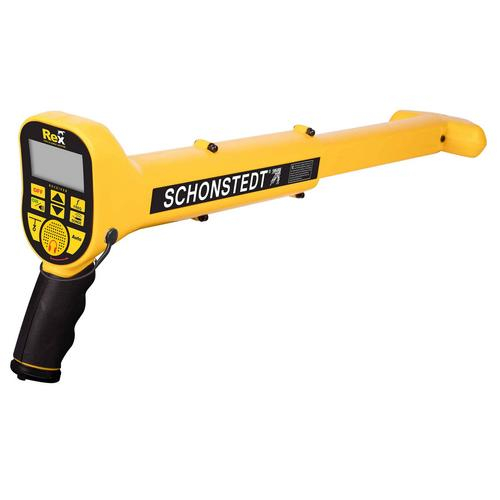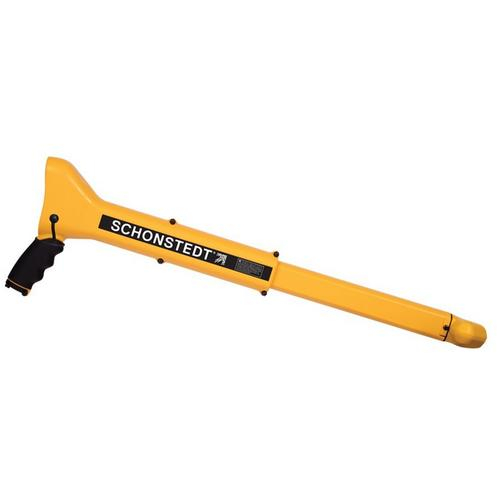- Show results for
- Share
Schonstedt Locators Comparison Charts
Resource Description

Schonstedt is a leading manufacturer of top-quality Underground Magnetic Locators and Pipe & Cable Locators. To learn more about underground locating, you are welcome to review our Guide to Pipe and Cable Locating.
With the company’s magnetic locators, it is easy to locate iron pipes, steel enclosures, well casings, etc.
Principles of Magnetic Locating
Schonstedt magnetic locators operate on the principle of detecting the difference in the magnetic field present at 2 sensors spaced a fixed distance apart. In the absence of a buried object, the field at both sensors is the same. The presence of an object made of iron or steel results in a difference between the magnetic field at the top and the bottom sensors. That difference is called a gradient. The company’s locators indicate the detection of a gradient to the user by changing the pitch of an audio tone and, depending on the model, with a bar graph on a visual display.
 |
.jpg) GA-52Cx GA-52Cx |
.jpg) GA-72Cd GA-72Cd |
 GA-92XTd GA-92XTd |
.jpg) MAGGIE MAGGIE |
.jpg) Spot Spot |
| Major Features | - Most Popular - Lower Cost - Highest Accurac |
- Most Rugged - Most Popular for UXO and Demining Applications |
Most Portable - Comes with Holster - Smallest - Most Ergonomic |
- Pistol-grip - Visual Display - Highest Accuracy |
Ultralightweight Lowest Cost Highest Accuracy |
| Audio Output | Yes | Yes | Yes | Yes | Yes |
| Visual Output | -- | Yes | Yes | Yes | -- |
| Battery Indicator | -- | Yes | Yes | Yes | -- |
| Sensitivity Indicator | -- | Yes | Yes | Yes | -- |
| Sensitivity Controls | 5 levels | 4 levels | Continuous | Continuous | Continuous |
| Headphone Compatible | Yes | Yes | Yes | Yes | -- |
Locate buried gas lines, tracer wire, water lines, etc. with Schonstedt cable and pipe detectors.
Principles of Pipe and Cable Locating
There are 2 methods of pipe and cable locating: active and passive. In active locating, a transmitter is used to impose the circulation of an electric current on the pipe or cable, and the receiver is used to detect the field created by the current. Active locating requires an electrical circuit through which current can flow. How can you achieve this? There are 3 different types of connections (active modes) for it:
- direct (conductive) - produces the largest amount of current;
- inductive clamp - produces less current (a great option if you don’t have enough access to the pipe or cable);
- inductive - produces less current than 2 other modes (should be used when other modes are not practical).
With the direct method, the direct connection to the pipe or cable must be made. In order to get a good signal, you need to apply the proper frequency. If conditions are good (conductor, connector, and soil conditions), the current will travel farther at the lowest frequency with less leakage to adjacent structures. It is recommended to start with the lowest frequency possible and increase as needed.
The inductive clamp method requires you to apply a clamp around the pipe or cable. At least one end (the far end), but preferably both, must be well-grounded.
In the inductive method, an antenna generates a signal that induces a current on the current pipe or cable. It is recommended to walk 15 to 10 feet away from the antenna before attempting to locate with the receiver.
In passive locating, the receiver detects a field created by the current that’s already circulating on the cable. No transmitter is required. The cable must be energized with a network distribution electrical current at a frequency of 60Hz or 50Hz. Passive locating should be used when other methods are not possible.
| PIPE & CABLE LOCATOR COMPARISON CHART |
 Rex |
 Rex Lite |
 XT-512 |
| Frequencies: | |||
| 512 Hz | Yes | Yes | -- |
| 33 kHz | Yes | Yes* | -- |
| 82 kHz | Yes | Yes* | -- |
| Sonde Mode: | |||
| 512 Hz | Yes | Yes | Yes |
| Passive modes: | |||
| 50 or 60 Hz | Yes | Yes | Yes |
| Passive Cathodic | opt | opt | opt |
| Batteries: | |||
| Receiver | 9V | 9V | 9V |
| Transmitter | Recharge | 10 AA | N/A |
| Other Features: | |||
| Manual Depth | Yes | Yes | Yes |
| Signal Strength | Yes | Yes | Yes |
| Directional Arrows | Yes | Yes | Yes |
| Good Circuit | Yes | -- | -- |
| Transmitter Power | Auto/Manual | Auto/Manual | -- |
| Clamp | opt | opt | -- |
| Inductive | Yes | Yes | -- |
| Auto & Manual Gain | Yes | Yes | Yes |
*Rex Lite has a choice of 33 kHz OR 82 kHz







